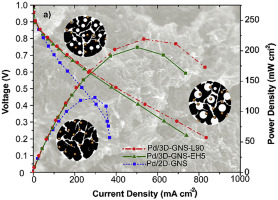Journal of Power Sources ( IF 8.1 ) Pub Date : 2017-09-01 , DOI: 10.1016/j.jpowsour.2017.08.092 Sadia Kabir , Alexey Serov , Plamen Atanassov

|
Hierarchically structured 3D-Graphene nanosheets as supports for palladium nanoparticles (Pd/3D-GNS) were fabricated using the Sacrificial Support Method. The pore size distribution of the 3D-GNS supports were tuned by utilizing smaller and larger sized sacrificial silica templates, EH5 and L90. Using a combination of Scanning Electron Microscopy (SEM), N2 sorption and Rotating Ring Disc Electrode (RRDE) technique, it was demonstrated that the EH5 and L90 modified 3D-GNS supports had higher percentage of micro- (<2 nm) and macropores (>50 nm), respectively. The templated pores also played a role in enhancing the oxygen reduction reaction (ORR) as well as membrane electrode assembly (MEA) performance of the Pd nanoparticles in comparison to non-porous 2D-GNS supports. Particularly, incorporation of micropores increased peroxide generation at higher potentials whereas presence of macropores increased both limiting current densities and reduce peroxide yields. Integration of the Pd/GNS nanocomposites into a H2/O2 fed Anion Exchange Membrane Fuel Cell (AEMFC) operating at 60C also demonstrated the effect of modified porosity on concentration polarization or transport losses at high current densities. This strategy for the tunable synthesis of hierarchically 3D porous graphitized supports offers a platform for developing morphologically modified nanomaterials for energy conversion.
中文翻译:

钯纳米颗粒的3D石墨烯载体:阴离子交换膜燃料电池中微孔/大孔对氧电还原的影响
使用牺牲支撑方法制造了作为钯纳米颗粒(Pd / 3D-GNS)载体的分层结构3D-石墨烯纳米片。3D-GNS载体的孔径分布可通过使用越来越小尺寸的牺牲性二氧化硅模板EH5和L90进行调整。结合使用扫描电子显微镜(SEM),N 2吸附和旋转环盘电极(RRDE)技术,证明EH5和L90修饰的3D-GNS载体分别具有较高的微孔(<2 nm)和大孔(> 50 nm)百分比。与无孔2D-GNS载体相比,模板化孔在增强Pd纳米颗粒的氧还原反应(ORR)和膜电极组件(MEA)性能方面也起着作用。特别地,微孔的引入在较高电势下增加了过氧化物的产生,而大孔的存在既增加了极限电流密度又降低了过氧化物的产率。将Pd / GNS纳米复合材料集成到以60°C运行的H 2 / O 2进料的阴离子交换膜燃料电池(AEMFC)中C还证明了在高电流密度下,改变的孔隙率对浓度极化或输运损耗的影响。用于分层3D多孔石墨化支撑体的可调合成的这种策略为开发用于能量转换的形态修饰的纳米材料提供了一个平台。











































 京公网安备 11010802027423号
京公网安备 11010802027423号